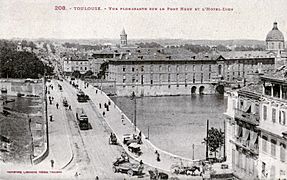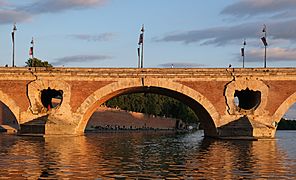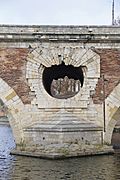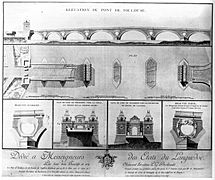Pont Neuf, Toulouse facts for kids
Quick facts for kids Pont Neuf, Toulouse |
|
|---|---|

Pont Neuf, Toulouse
|
|
| Coordinates | 43°35′58″N 1°26′19″E / 43.599307°N 1.438724°E |
| Crosses | Garonne |
| Locale | Toulouse |
| Official name | Pont de Pierre |
| Characteristics | |
| Design | arch bridge |
| Material | stone |
| Longest span | approximately 30 metres (98 ft) |
| Number of spans | 7 |
| History | |
| Designer | Jacques Le Mercier (Lemercier) Pierre Souffron |
| Construction begin | 1544 |
| Construction end | 1632 |
The Pont Neuf is a famous bridge in Toulouse, a city in the South of France. Its name means "New Bridge" in French. Even though it's called the "New Bridge," it was actually built a very long time ago, in the 16th and 17th centuries! It is also known as the Pont de Pierre (Stone Bridge) or Grand Pont (Great Bridge).
Construction on the Pont Neuf started in 1544 and finished in 1632. Building it was quite hard because of strong floods from the Garonne river. The ground underneath was also not very stable. The architect Jacques Lemercier helped finish the bridge in the early 1600s. He made it a very modern and clever bridge for its time.
Contents
Building the Pont Neuf
Why the Bridge Was Built
City leaders in Toulouse, called capitouls, first thought about building a big bridge in the late 1400s. King Francis I strongly supported the idea. He saw the bridge as important for defending France against Charles V of Spain, who was a threat at that time.
A Masterpiece of Design
The Pont Neuf in Toulouse is seen as a great example of bridge building from the Renaissance period. This was a time when art and science were reborn in Europe. Local builders from Toulouse started the project. Later, the Parisian architect Jacques Lemercier completed it.
This bridge was special because it didn't have houses or shops built on top of it. Many older bridges in medieval times were crowded with buildings. The Pont Neuf was part of a new style of bridges that were clear and open.
Lemercier used ideas from ancient Roman bridges. For example, he added openings in the bridge's supports (called piers). These openings helped spread the river's current. He also used ideas from Italian Renaissance bridges. These included round openings, called oculi, and arches that were not too high, which helped keep the bridge level.
Construction Timeline
Planning for the bridge began in 1542. A group of expert builders and carpenters met to design it. Work on the foundations started in 1544. The first arch of the bridge began to take shape in 1614.
The entire bridge was finished and opened for use in 1632. It was officially opened on October 19, 1659, by King Louis XIV. The bridge's strong design helped it survive a terrible flood in 1875. This flood destroyed all other bridges in Toulouse, even newer ones, and many houses.
Unique Features
The Pont Neuf is 220 meters (about 720 feet) long. It has 7 arches that cross the Garonne river. The bridge is not perfectly straight. This is because the left bank of the river is lower than the right bank. The longest arch is the third one from the right side.
The openings in the bridge's piers were originally meant to look like a lion's face and mane. In 1642, a large archway was added to the bridge. However, it made traffic difficult, so it was removed in 1860.
Gallery
See also
 In Spanish: Pont Neuf (Toulouse) para niños
In Spanish: Pont Neuf (Toulouse) para niños
- Renaissance architecture of Toulouse







